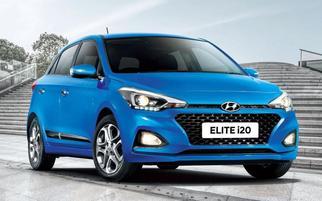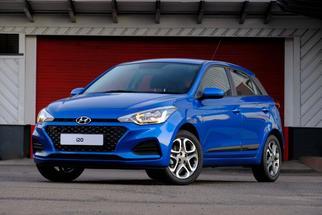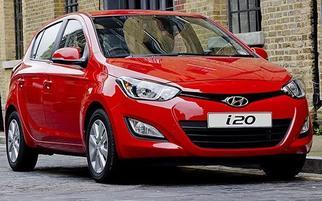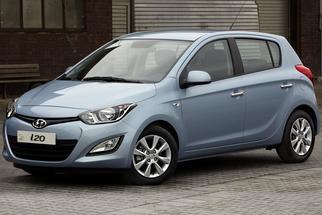Technical specs may differ depending on trim
Engine power
84 - 120 hp @ 6000 - 6000 rpm | 63 - 89 kW
Torque
118 - 200 Nm @ 1500 - 4000 rpm | 87 - 147 lb-ft
0 to 100 km/h Acceleration
10.2 - 13.1 sec
Drive type
Front wheel drive, Rear wheel drive
Technical specs may differ depending on trim
2020 - to present
2018 - 2020
2018 - 2020
2014 - 2018
2012 - 2014
2009 - 2012

Engine power
84 - 120 hp @ 6000 - 6000 rpm | 63 - 89 kW
Torque
118 - 200 Nm @ 1500 - 4000 rpm | 87 - 147 lb-ft
0 to 100 km/h Acceleration
10.2 - 13.1 sec
Drive type
Front wheel drive, Rear wheel drive
Engine displacement
998 - 1197 cc
Number of cylinders
4, 3
Transmission Type
5 (Manual), 6 (Manual), 7 DCT (Automatic), 6 iMT (Manual)
Powertrain
Internal Combustion , MHEV (Mild Hybrid Electric Vehicle)
Position of cylinders
Inline
Turbocharger
Yes
Fuel type
Petrol (Gasoline), petrol / electricity
Fuel supply
Multi-point indirect, Direct injection
Emission standard
Euro 6d
Wheelbase
2580 mm | 102 in.
Length
4040 mm | 159 in.
Width
1750 mm | 69 in.
Height
1450 mm | 57 in.
Trunk space (min)
351 L | 12.4 cu-ft
Number of doors
5
Number of seats
5
Rim size
R16; R17, 6.5J x 16, R17, R15
Tire size
225/60 R16; 225/55 R17, 275/35 R19, 225/60 R16, 225/55 R17, 225/65 R15

Engine power
83 - 90 hp @ 4000 - 6000 rpm | 62 - 67 kW
Torque
115 - 220 Nm @ 1500 - 4000 rpm | 85 - 162 lb-ft
Drive type
Front wheel drive
Engine displacement
1197 - 1396 cc
Number of cylinders
4
Engine location
Front, Transverse
Transmission Type
5 (Manual), CVT (Automatic), 6 (Manual)
Powertrain
Internal Combustion
Valvetrain
DOHC, Dual VTVT, DOHC
Position of cylinders
Inline
Valves per cylinder
4
Turbocharger
Yes
Fuel type
Petrol (Gasoline), Diesel
Fuel tank
40 L | 10.6 gallons
Fuel supply
Diesel Commonrail
Wheelbase
2570 mm | 101 in.
Length
3985 mm | 157 in.
Width
1734 mm | 68 in.
Height
1505 mm | 59 in.
Number of doors
5
Number of seats
5
Rim size
R17, R15
Tire size
225/55 R17, 195/65 R15, 205/65 R15

Engine power
75 - 120 hp @ 4500 - 6000 rpm | 56 - 89 kW
Torque
122 - 172 Nm @ 1500 - 4000 rpm | 90 - 127 lb-ft
0 to 100 km/h Acceleration
10.2 - 13.6 sec
Drive type
Front wheel drive
Top speed
160 - 190 km | 99 - 118 mph
Engine displacement
998 - 1248 cc
Number of cylinders
3, 4
Turbocharger
Yes
Engine location
Front, Transverse
Cylinder bore
71 mm
Transmission Type
7 DCT (Automatic), 5 (Manual), 6 (Manual)
Powertrain
Internal Combustion
Valvetrain
D-CVVT, DOHC-CVVT
Position of cylinders
Inline
Piston stroke
78.8 - 84 mm
Compression
10 - 10.5 mm
Valves per cylinder
4
Fuel consumption (city)
5.9 - 7.2 l/100 km | 39.9 - 32.7 mpg(USA)
Fuel consumption (highway)
4.6 - 5 l/100 km | 51.1 - 47 mpg(USA)
Fuel consumption (combined)
5.1 - 5.8 l/100 km | 46.1 - 40.6 mpg(USA)
Fuel type
Petrol (Gasoline)
Fuel supply
Direct injection, Multi-point indirect
Fuel tank
50 L | 13.2 gallons
CO2 emissions
117 - 132 g/km | 188 - 212 g/mile
Emission standard
Euro 6d
Wheelbase
2570 mm | 101 in.
Front track
1514 mm | 60 in.
Rear track
1513 mm | 60 in.
Length
4035 mm | 159 in.
Width
1734 mm | 68 in.
Height
1474 mm | 58 in.
Ride height
140 mm | 5.5 in.
Width including mirrors
1985 mm | 78 in.
Front overhang
815 mm | 32 in.
Rear overhang
650 mm | 26 in.
Towing capacity with 12% brakes
800 - 1110 kg | 1764 - 2448 lbs
Trunk space (min)
326 L | 11.5 cu-ft
Trunk space (max)
1024 L | 36.2 cu-ft
Towing capacity
450 kg | 992 lbs
Maximum roof load
70 kg | 154 lbs
Max weight
1580 - 1650 kg | 3484 - 3638 lbs
Towbar download
75 kg | 165 lbs
Number of doors
5
Curb weight
1055 - 1185 kg | 2326 - 2613 lbs
Number of seats
5
Rim size
R15, R13
Tire size
195/60 R15, 155/80 SR13

Engine power
75 - 120 hp @ 4000 - 6000 rpm | 56 - 89 kW
Torque
122 - 240 Nm @ 1500 - 4000 rpm | 90 - 177 lb-ft
0 to 100 km/h Acceleration
10.2 - 16 sec
Drive type
Front wheel drive, All wheel drive (4x4)
Top speed
159 - 190 km | 99 - 118 mph
Engine displacement
998 - 1396 cc
Number of cylinders
4, 3
Engine location
Front, Transverse
Cylinder bore
71 - 75 mm
Transmission Type
5 (Manual), 6 (Manual), 4 (Automatic)
Powertrain
Internal Combustion
Valvetrain
DOHC
Position of cylinders
Inline
Piston stroke
78.8 - 84.5 mm
Compression
10 - 16 mm
Valves per cylinder
4
Turbocharger
Yes
Fuel consumption (city)
3.5 - 9.2 l/100 km | 67.2 - 25.6 mpg(USA)
Fuel consumption (highway)
3.1 - 5.3 l/100 km | 75.9 - 44.4 mpg(USA)
Fuel consumption (combined)
3.3 - 6.7 l/100 km | 71.3 - 35.1 mpg(USA)
Fuel type
Petrol (Gasoline), Diesel
Fuel supply
Multi-point indirect, Diesel Commonrail, Direct injection
Fuel tank
50 L | 13.2 gallons
CO2 emissions
84 - 155 g/km | 135 - 249 g/mile
Emission standard
Euro 6
Wheelbase
2570 mm | 101 in.
Front track
1514 - 1520 mm | 60 in.
Rear track
1513 - 1519 mm | 60 in.
Length
4035 mm | 159 in.
Width
1734 mm | 68 in.
Height
1474 mm | 58 in.
Ride height
140 mm | 5.5 in.
Front overhang
815 mm | 32 in.
Rear overhang
650 mm | 26 in.
Trunk space (min)
326 L | 11.5 cu-ft
Trunk space (max)
1042 L | 36.8 cu-ft
Maximum roof load
70 kg | 154 lbs
Max weight
1580 - 1690 kg | 3484 - 3726 lbs
Number of doors
5
Curb weight
1040 - 1165 kg | 2293 - 2569 lbs
Number of seats
5
Towing capacity with 12% brakes
1000 - 1110 kg | 2205 - 2448 lbs
Towing capacity
450 kg | 992 lbs
Rim size
R14, R15, R16
Tire size
185/70 R14, 195/60 R15, 215/65 R16

Engine power
75 - 101 hp @ 4000 - 6000 rpm | 56 - 75 kW
Torque
137 - 1207 Nm @ 1500 - 4200 rpm | 101 - 890 lb-ft
0 to 100 km/h Acceleration
11.6 - 15.7 sec
Drive type
Front wheel drive, Rear wheel drive
Top speed
160 - 181 km | 99 - 112 mph
Engine displacement
1120 - 1396 cc
Number of cylinders
4, 3
Engine location
Front, Transverse
Cylinder bore
71 - 77 mm
Transmission Type
5 (Manual), 6 (Manual), 4 (Automatic)
Powertrain
Internal Combustion
Valvetrain
DOHC
Position of cylinders
Inline
Piston stroke
74.9 - 84.5 mm
Compression
10.5 - 17 mm
Valves per cylinder
4
Turbocharger
Yes
Fuel consumption (city)
4.6 - 7.7 l/100 km | 51.1 - 30.5 mpg(USA)
Fuel consumption (highway)
3.4 - 4.7 l/100 km | 69.2 - 50 mpg(USA)
Fuel consumption (combined)
3.8 - 5.8 l/100 km | 61.9 - 40.6 mpg(USA)
Fuel type
Petrol (Gasoline), Diesel
Fuel supply
Multi-point indirect, Diesel Commonrail
Fuel tank
45 L | 11.9 gallons
Emission standard
Euro 5
Wheelbase
2525 mm | 99 in.
Front track
1503 mm | 59 in.
Rear track
1501 mm | 59 in.
Length
3940 mm | 155 in.
Width
1710 mm | 67 in.
Height
1490 mm | 59 in.
Trunk space (min)
295 L | 10.4 cu-ft
Trunk space (max)
1060 L | 37.4 cu-ft
Max weight
1515 - 1650 kg | 3341 - 3638 lbs
Number of doors
5
Curb weight
970 - 1115 kg | 2139 - 2459 lbs
Number of seats
5
Rim size
R15, R16
Tire size
205/65 R15, 215/75 R15, 195/65 R15, 225/55 R16

Engine power
75 - 128 hp @ 4000 - 6300 rpm | 56 - 95 kW
Torque
119 - 260 Nm @ 1750 - 4200 rpm | 88 - 192 lb-ft
0 to 100 km/h Acceleration
9.5 - 16.2 sec
Drive type
Front wheel drive, Rear wheel drive
Top speed
161 - 190 km | 100 - 118 mph
Engine displacement
1248 - 1591 cc
Number of cylinders
4
Engine location
Front, Transverse, Front, Longitudinal
Cylinder bore
75 - 77.2 mm
Transmission Type
4 (Automatic), 5 (Manual), 6 (Manual)
Powertrain
Internal Combustion
Valvetrain
DOHC
Position of cylinders
Inline
Piston stroke
75 - 85.4 mm
Compression
10.5 - 17.3 mm
Valves per cylinder
4
Turbocharger
Yes
Fuel consumption (city)
5.5 - 8.4 l/100 km | 42.8 - 28 mpg(USA)
Fuel consumption (highway)
3.8 - 5.4 l/100 km | 61.9 - 43.6 mpg(USA)
Fuel consumption (combined)
4.4 - 6.5 l/100 km | 53.5 - 36.2 mpg(USA)
Fuel type
Petrol (Gasoline), Diesel
Fuel supply
Multi-point indirect, Diesel Commonrail
Fuel tank
45 L | 11.9 gallons
CO2 emissions
117 - 152 g/km | 188 - 245 g/mile
Emission standard
Euro 4, Euro 5
Wheelbase
2525 mm | 99 in.
Front track
1487 - 1505 mm | 59 in.
Rear track
1485 - 1503 mm | 58 - 59 in.
Length
3940 mm | 155 in.
Width
1710 mm | 67 in.
Height
1490 mm | 59 in.
Ride height
150 mm | 5.9 in.
Trunk space (min)
295 L | 10.4 cu-ft
Trunk space (max)
1045 - 1060 L | 36.9 - 37.4 cu-ft
Max weight
1515 - 1650 kg | 3341 - 3638 lbs
Number of doors
5
Curb weight
1025 - 1223 kg | 2260 - 2697 lbs
Number of seats
5
Rim size
R14, R15, R13, 5.5J x 14
Tire size
185/70 R14, 195/60 R15, 245/40 R17, 155/80 SR13